Northwest Michigan fruit update – June 14, 2022
Despite the cooler weather last week, fruit size increased significantly. Growers have been concentrating on apple thinning, and this process has been difficult with the cool conditions.

Weather report
The past weekend was pleasant and sunny with a touch of drizzle on Saturday into Sunday (June 11-12). The weather is predicted to change again after today, June 14, when conditions will be much warmer with high humidity. Tomorrow will be the hottest day of the week, and our region is forecasted to be in the 80s, but daytime highs may hit close to 100 degrees Fahrenheit in the southern part of the state.
The state is predicted to have extreme heat and very high dew points. Dew points may hit in the mid-70s, which Jeff Andresen says is very high for Michigan and unusual. The next 48 hours will be hot and humid, then the cooler weather will be back in the region. We may set records for the overnight temperatures, which may only drop into the mid 70s.
There will be a huge demand for water—conditions will be more like the southwestern U.S. than Michigan, and we are expected to see some of the highest demands for water that we see in the state over the next two days. By Thursday, cool weather will push out the hot and humid air. Warm weather is predicted to return next week.
Despite the fluctuations in temperatures over the past month, we have accumulated 881 growing degree days (GDD) base 42 and 490 GDD base 50 for the Northwest Michigan Horticulture Research Center (NWMHRC). Our 33-plus-year average is 899.9 GDD base 42 and 491.4 GDD base 50.
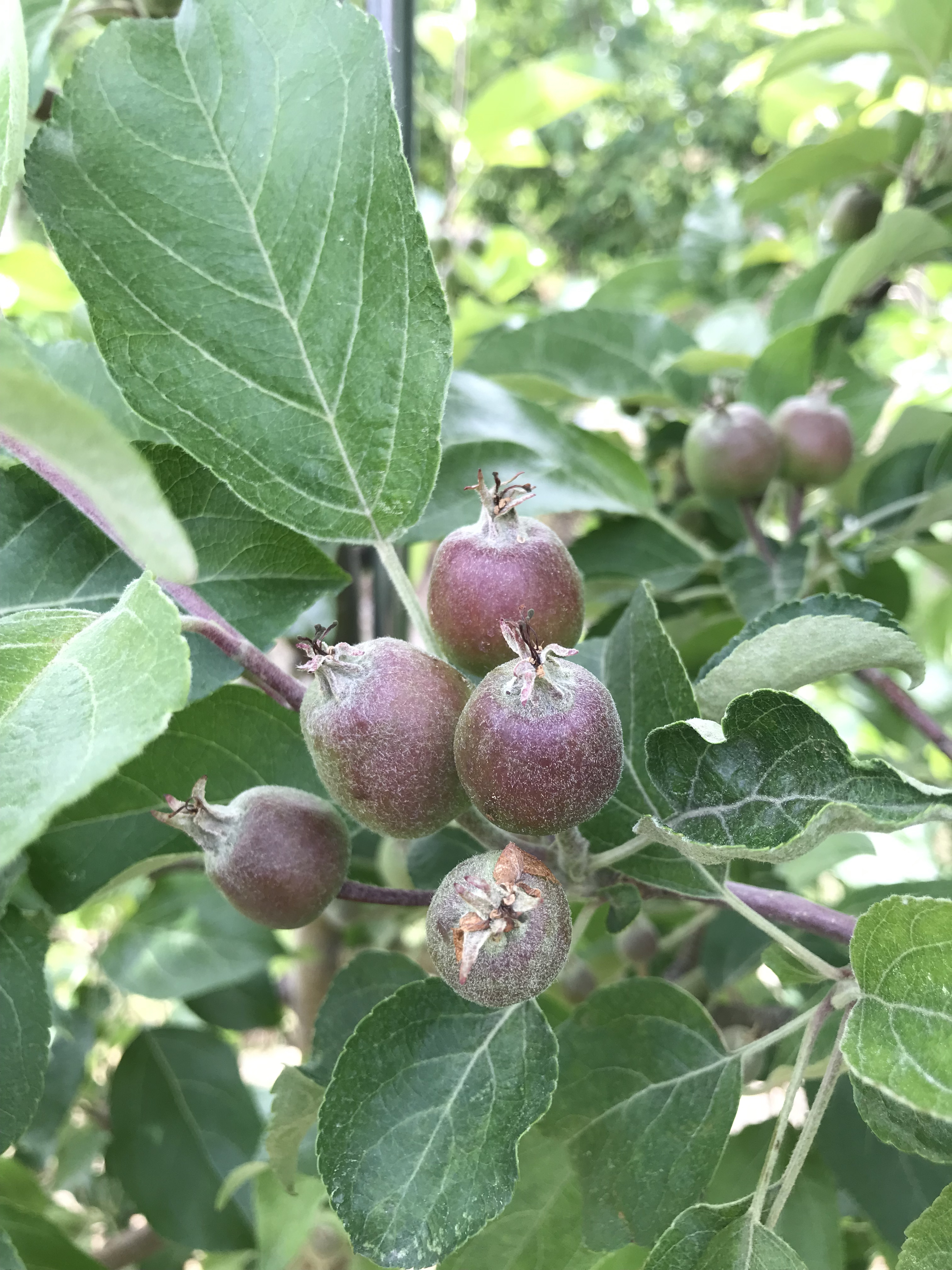
Crop report
Apples are sizing from last week, and they are approaching the size where they are too big to thin. The Honeycrisp at the NWMHRC are 21mm, and the Gala are 19mm. We have had reports of growers having issues with thinning this season. As most growers know, thinners work better under warmer temperatures: >65 F. The weather conditions were not particularly warm last week, and likely caused the poor thinning activity. We applied Sevin and NAA twice this season on June 2 and 8, and our fruitset model output is still showing we have too many fruit on our trees (Figure 3).
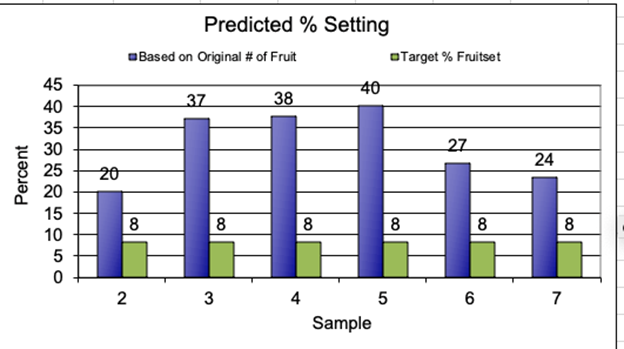
For the second thinning application, we used Sevin and 10oz of NAA, which would have been a 30% increase in thinners. This high rate still did not result in a significant drop in fruit. With fruit at or approaching 20mm, it becomes much harder to thin. The Michigan State University Extension fruit team is recommending the combination of NAA and Sevin coupled with oil to improve the material’s penetration. At this point, this thinner application is the Hail Mary to try to remove fruit before hand-thinning is the only option. The carbohydrate model is still showing to increase thinners by 30% with the surplus in carbohydrates (Figures 4 and 5).
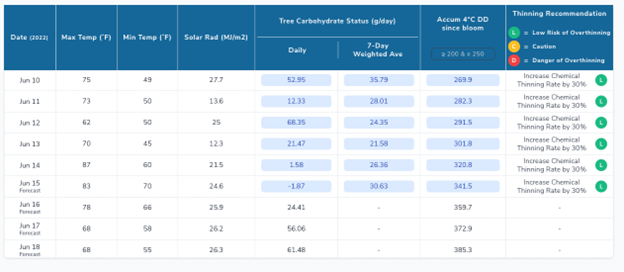
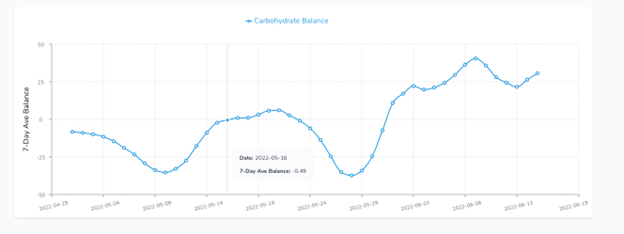
Pest report
San Jose scale. We caught no San Jose scale this week, which is likely a result of the cooler weather. We expect activity to pick up with this warmer weather. Growers with past issues should keep an eye out for crawlers.
Lesser peach tree borer. We caught an average of 13 lesser peach tree borer this week. Last week, we caught an average of 16.7 moths.
American plum borer. We caught an average of 2.6 American plum borer moths this week.
Plum curculio. This weather forecast also looks good for an increase in plum curculio activity. Again, this pest thrives in warm and humid conditions. Growers should protect fruit from plum curculio. We found plum curculio stings in an apple block at the NWMHRC on Monday.
Black stem borer. We caught an average of 0.5 black stem borers this week. Growers with black stem borers issues in past should be considering control strategies. Unfortunately, Lorsban is no longer an option for control of this pest. Warm weather will increase beetle activity.
Codling moth. We caught an average of 1.7 codling moth this week. These numbers are quite low even though we have captured moths for three weeks in a row. This pest flies at dusk when temperatures are warm; this forecasted warm and humid night temperatures will be conducive for codling moth flight and mating. The weather conditions in the forecast will likely result in a significant codling moth flight and mating; this cohort will need to be controlled as it will pose a threat to developing fruit. Growers should be trapping for this pest in their individual blocks as codling moth population sizes vary in different orchards.
Disease report
Cherry leaf spot. We had a leaf spot infection on June 5.

Powdery mildew. This disease loves warm and dry weather. The forecast is predicting optimal conditions for mildew infection.
Apple scab. Growers have done a great job keeping scab in check this season. The RIMpro model is predicting the next scab infection period June 16 (Figure 7). After the next rainfall, we should be able to call the end to primary scab season.
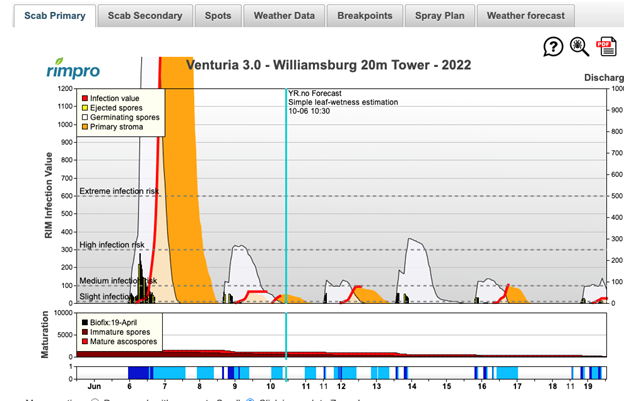



 Print
Print Email
Email
